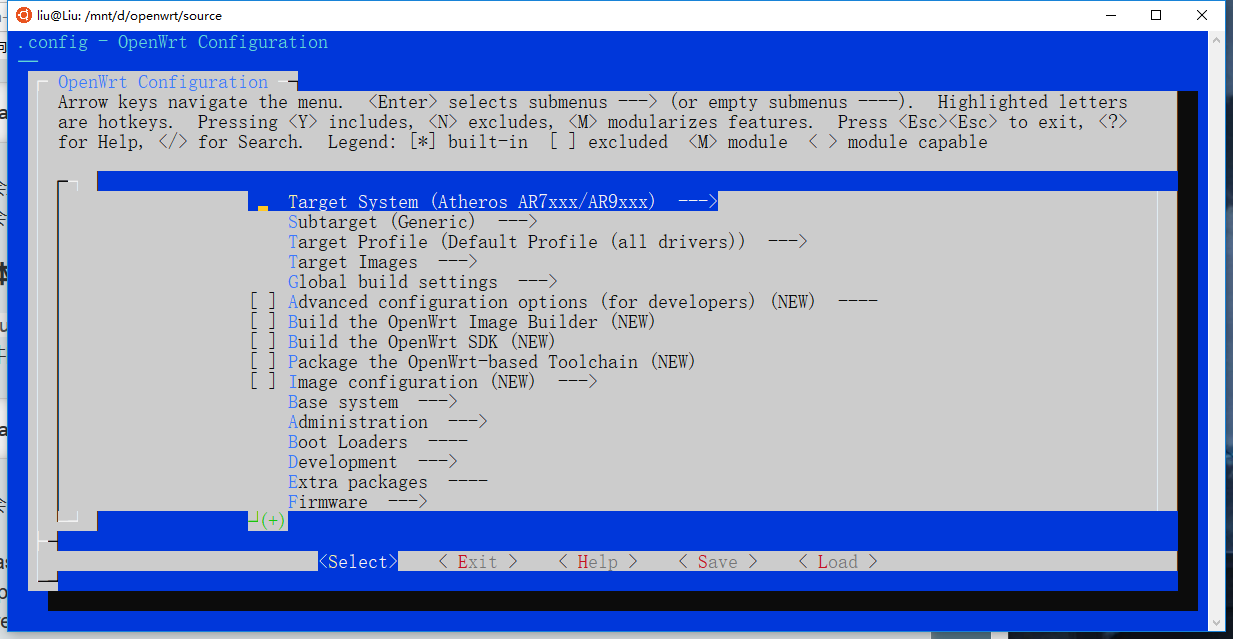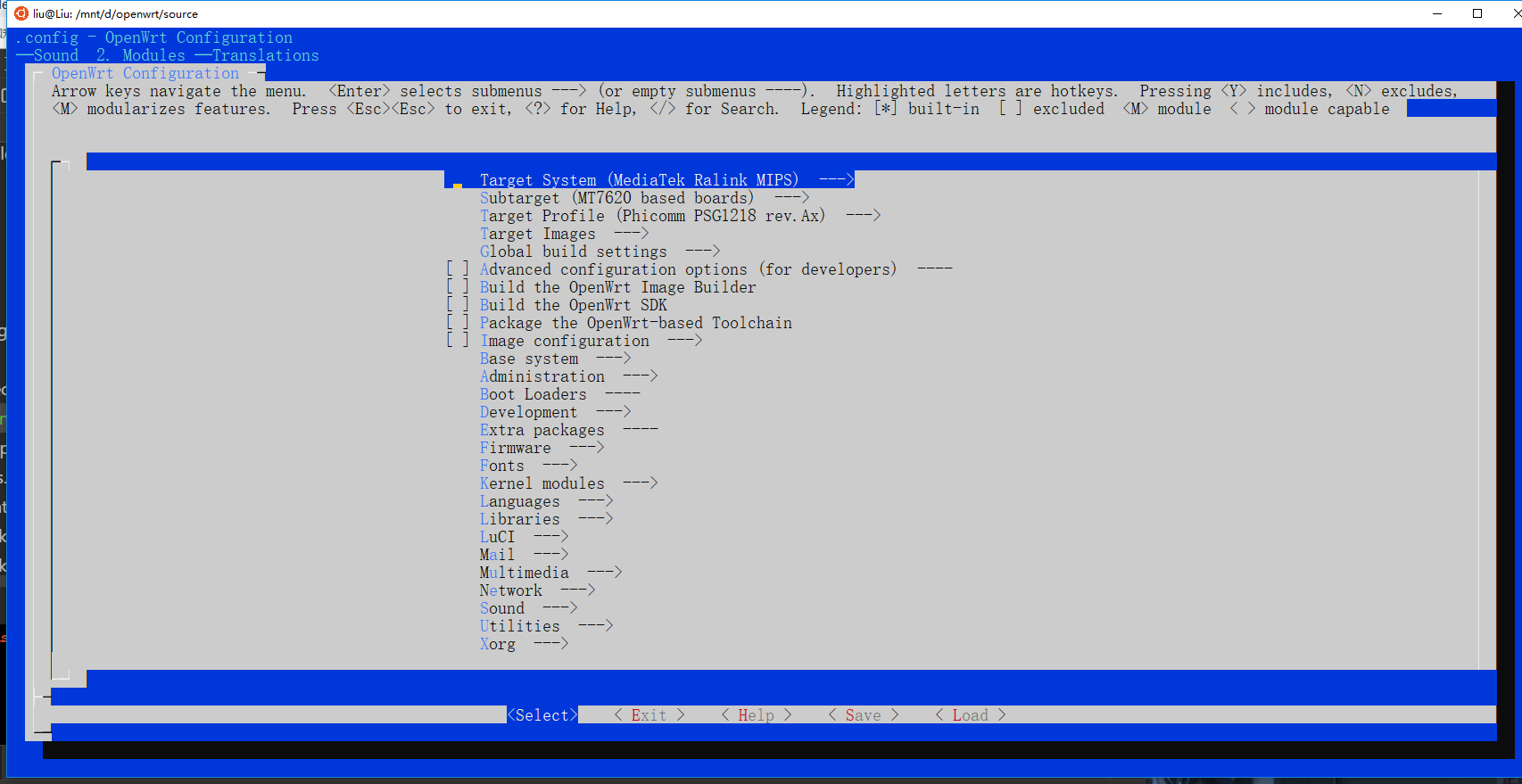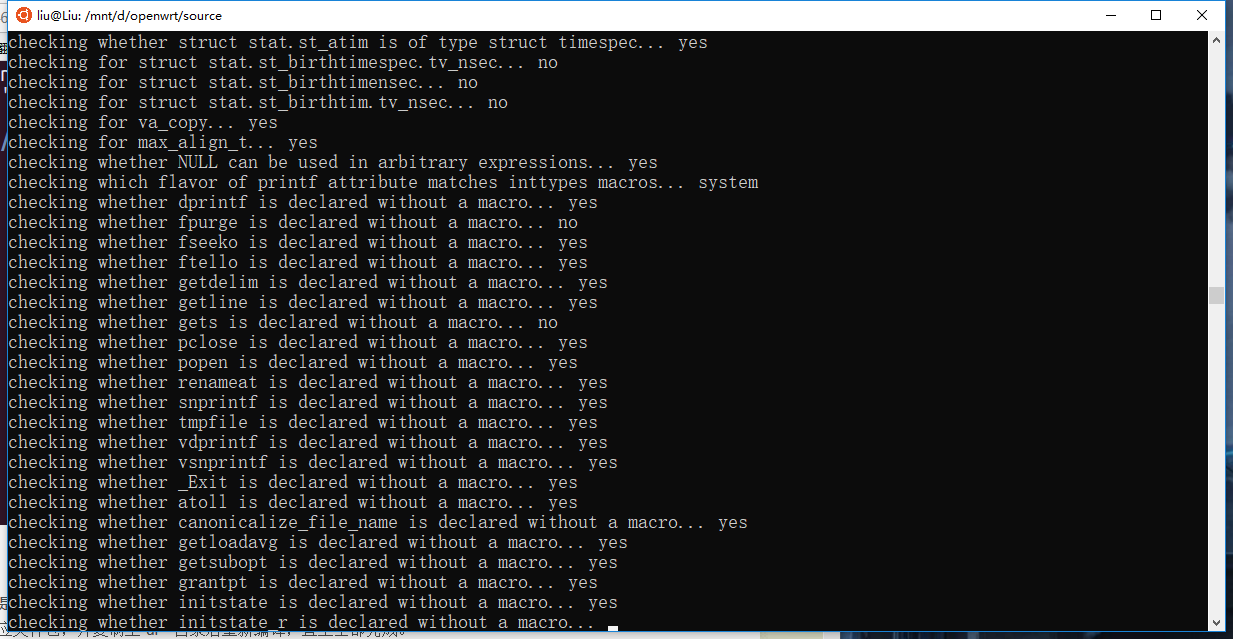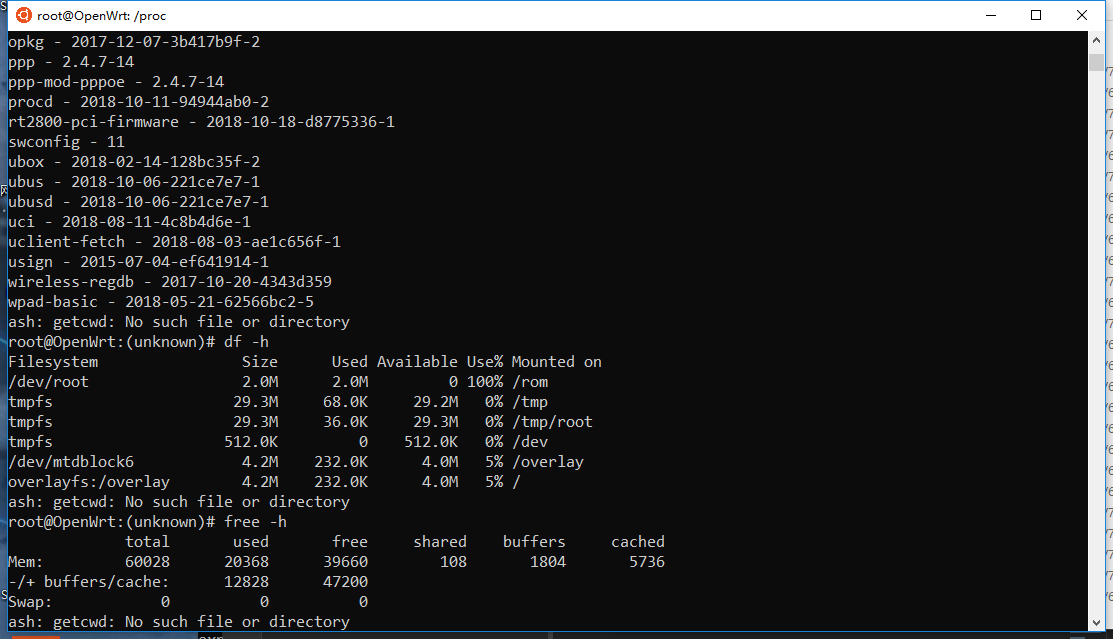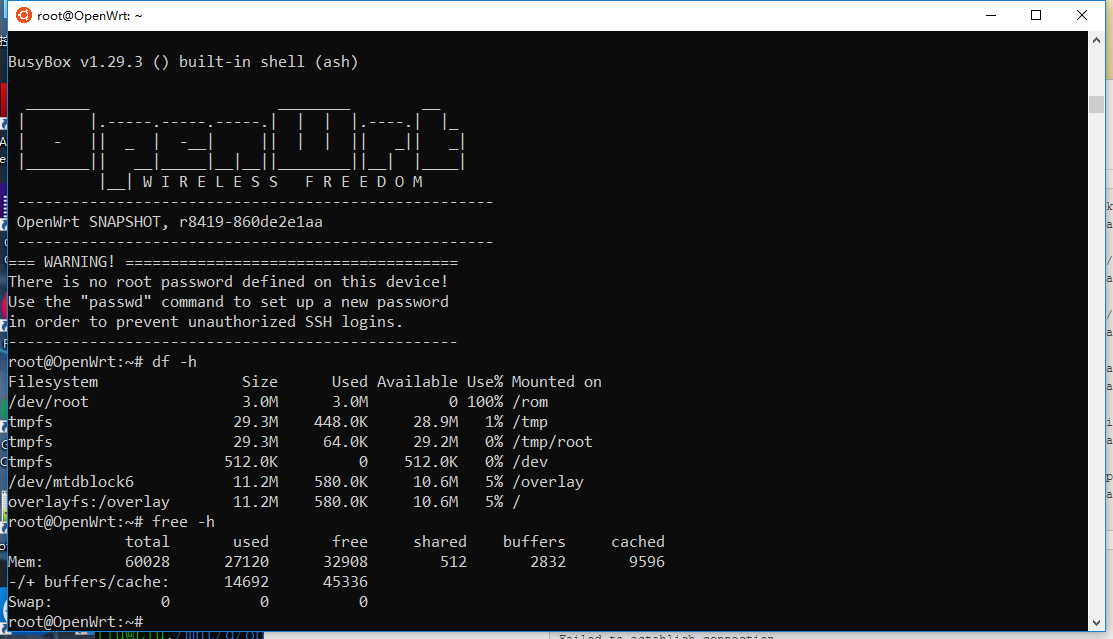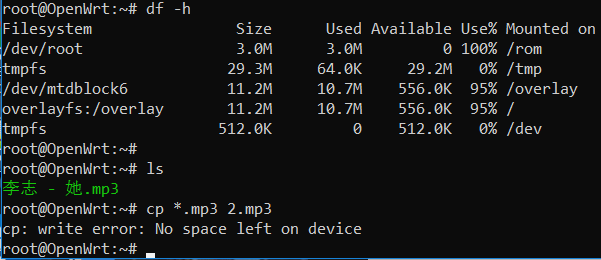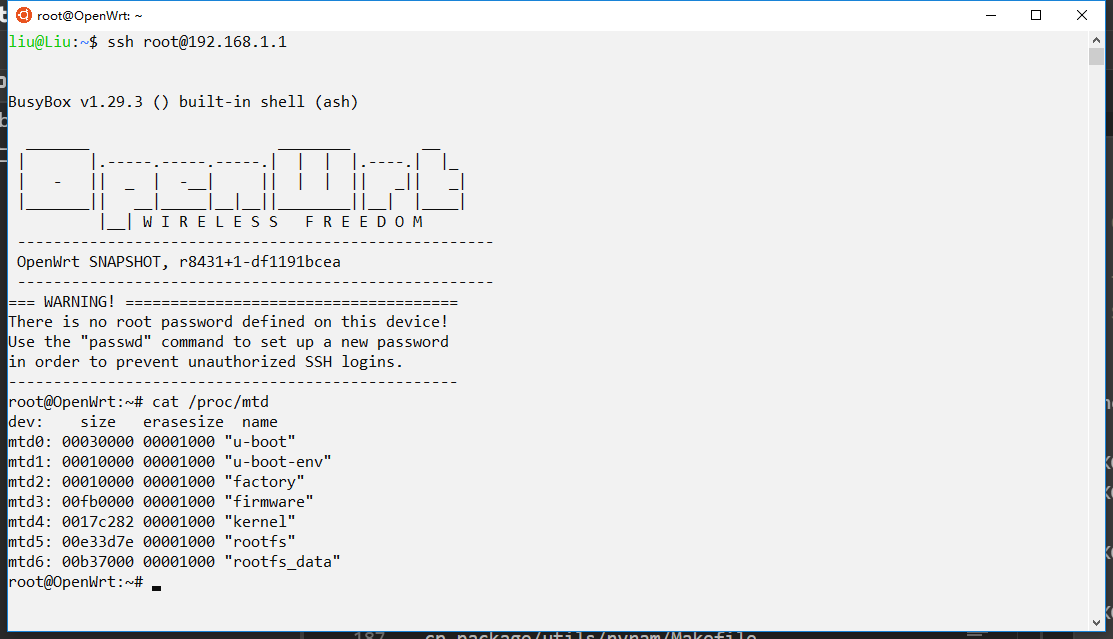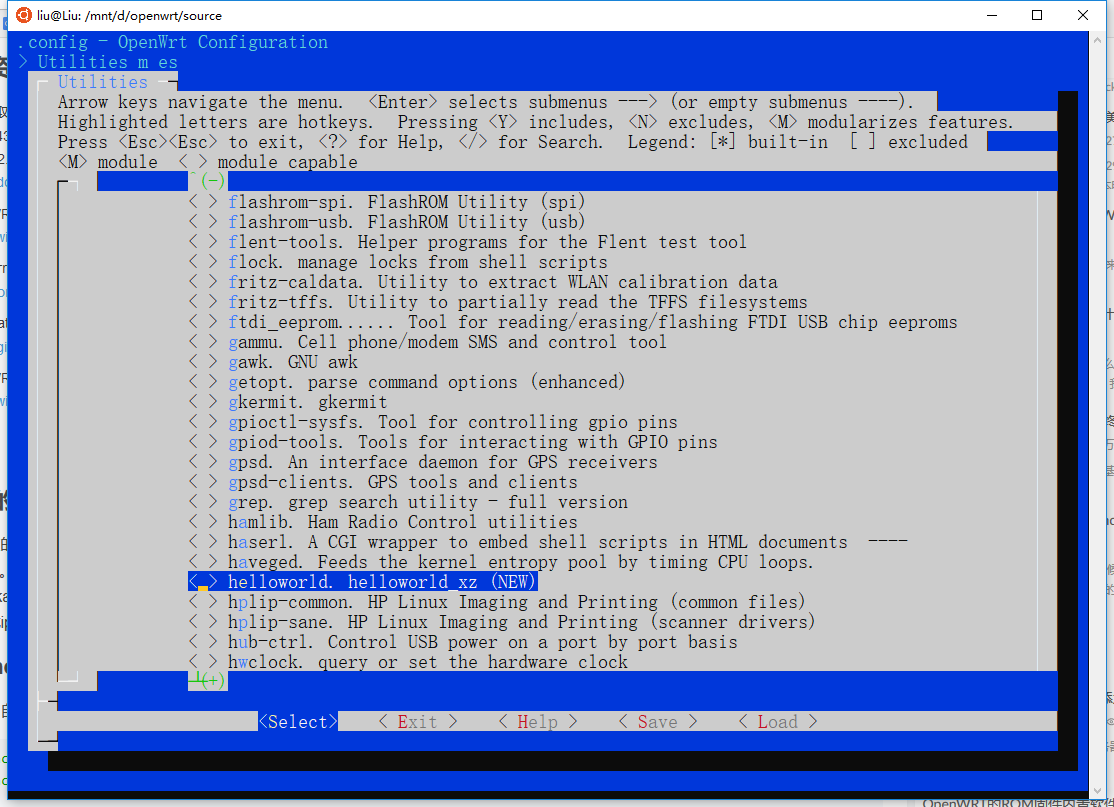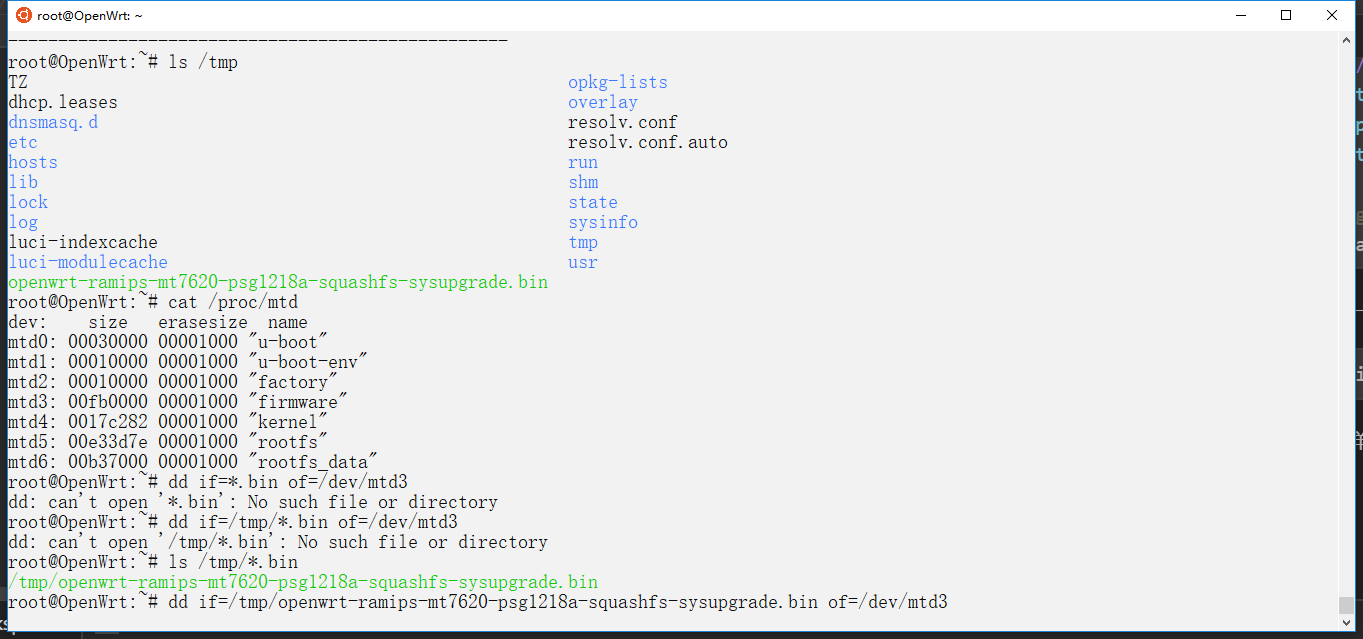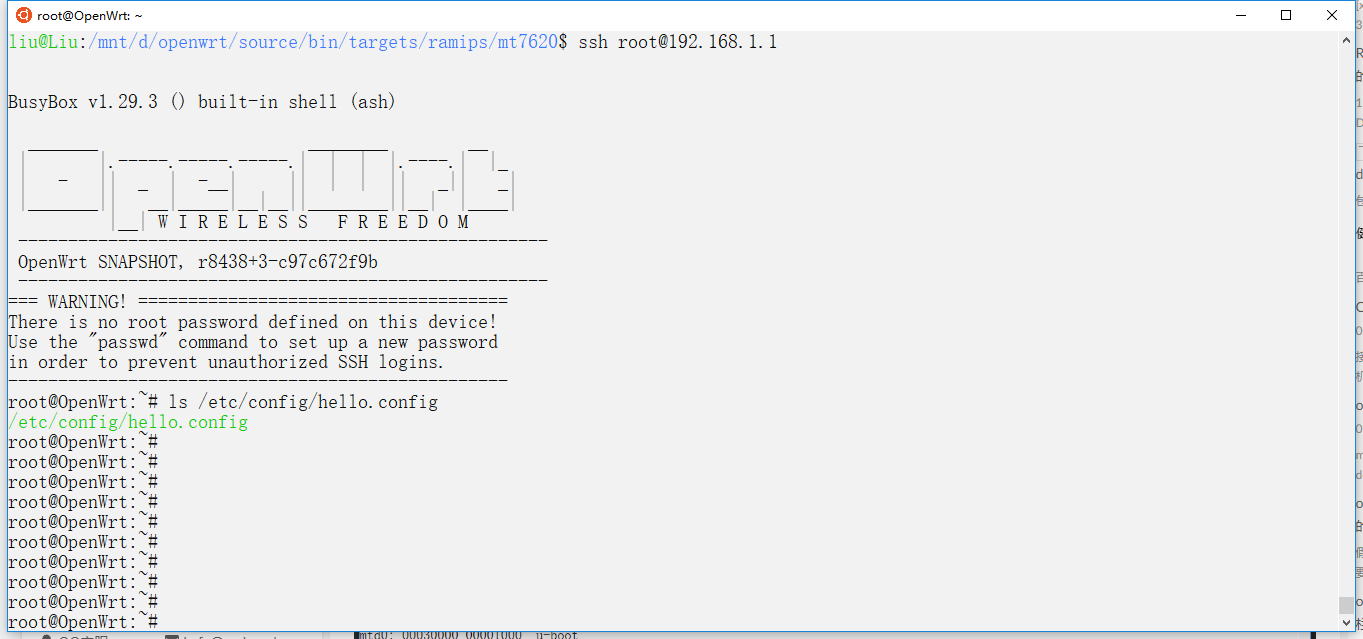前言 OpenWRT是一个高度模块化、自动化的嵌入式Linux系统,拥有强大的网络组建和扩展性,常常被用于工控设备、电话、小型机器人、智能家居、路由器以及VOIP设备中,其中在智能路由器上有广泛使用。同时它还提供了100多个已编译好的软件,而且数量还在不断增加。
OpenWRT支持各种处理器架构,无论是ARM、X86、PowerPC或者MIPS都有很好的支持。其多达3000多种软件包,囊括从工具链(toolchain),到内核(Linux Kernel),到软件包(packages),再到根文件系统(rootfs)整个体系,是的开发者只需要简单的一个make命令就可以方便快速的定制一个具有特定功能的嵌入式系统。
对于想学习嵌入式Linux开发的工程师来说,OpenWRT是非常适合的(引用)
我第一次接触Openwrt是在2013年,那是正是高二,家里有一个TP-Link的wr740路由器,mips架构,4M的Flash,16M的内存,当时刷过dd-wrt和openwrt。
第二次是在大二了,当时为了用路由器上校园网,撸了几台k2,研究了如何在openwrt等第三方路由器固件下实现锐捷和安腾的认证。
今天我要给k2编译一下Openwrt最新的Snapshot固件,顺便解决一下不识别16M闪存的问题。
编译环境
Ubuntu 18.06 Windows SubSystem Linux
硬盘 > 100G
编译所需dependencies就不说了
同步源码 1 git clone https://github.com/lede-project/source.git
并不很大,几百Mb。主要是后面编译的时候还要在线下载很多东西。
目录结构如下
1 2 3 4 5 6 7 8 . ├── tools – automake, autoconf, sed, cmake ├── toolchain/binutils – as, ld, … ├── toolchain/gcc – gcc, g++, cpp, … ├── target/linux – kernel modules ├── package – core and feed packages ├── target/linux – kernel image └── target/linux/image – firmware image file generation
Feeds 更新源:
1 ./scripts/feeds update -a
依据feeds.conf.default文件中的仓库地址来下载相应的软件,它提供了一些额外的扩展。
安装源:
1 ./scripts/feeds install -a
如果少了一些依赖会提示:
1 2 3 4 5 6 7 8 9 WARNING: Makefile 'package/utils/busybox/Makefile' has a dependency on 'libpam', which does not exist WARNING: Makefile 'package/utils/busybox/Makefile' has a build dependency on 'libpam', which does not exist WARNING: Makefile 'package/network/utils/curl/Makefile' has a dependency on 'libgnutls', which does not exist WARNING: Makefile 'package/network/utils/curl/Makefile' has a dependency on 'libopenldap', which does not exist WARNING: Makefile 'package/network/utils/curl/Makefile' has a dependency on 'libidn2', which does not exist WARNING: Makefile 'package/network/utils/curl/Makefile' has a dependency on 'libssh2', which does not exist WARNING: Makefile 'package/boot/kexec-tools/Makefile' has a dependency on 'liblzma', which does not exist WARNING: Makefile 'package/network/services/lldpd/Makefile' has a dependency on 'libnetsnmp', which does not exist WARNING: Makefile 'package/network/utils/nftables/Makefile' has a dependency on 'jansson', which does not exist
这时候我谷歌了一番
于是我也re-run了一番。。。
1 2 3 4 5 Collecting package info: done Installing all packages from feed packages. Installing all packages from feed luci. Installing all packages from feed routing. Installing all packages from feed telephony.
结果没报错。。。这真的是玄学吗
编译 然后就是编译了,执行make menuconfig,menuconfig拥有一个文本界面,包括处理的目标平台,要编译的软件包,要被包含进固件的软件包和一些内核设置,长这样:
这边有三种选项:
< > 该代码将不会被编译<M> 该代码将被交叉编译,生成的ipk软件包将被放在 /bin/packages/mipsel_24kc/base(以mt7620为例), 但该软件包不会放入固件中,需要你自己去安装<X> 该代码将被放入固件中 (on the SqashFS partition)
K2,故选择Target System 为(MediaTek Ralink MIPS),Subtarget为(MT 7620 based boards),由于K2是有官方资瓷的,所以Target Profile选择(Phicomm PSG1218 rev.A,rev.B应该是K2P)
同时LuCi要勾一下(Luci - Collections - luci和Luci - modules - translation - Chinese)
弄完save一下,保存为默认的.config
按两下exit退出,输入
开始编译,这里最好不要用多线程编译,我一开始-j4总是出错,编译的时候不能断网,会下载很多东西,然后就是漫长的等待了。
支持16Mb闪存 之前刷OP官方提供的固件,闪存只识别为8M,所以要修改一下 \source\target\linux\ramips\dts\PSG1218.dtsi
1 2 3 4 5 6 7 8 9 10 11 12 13 14 15 16 17 18 19 20 21 22 23 24 25 26 27 28 29 30 31 32 33 34 m25p80@0 { compatible = "jedec,spi-nor"; reg = <0>; spi-max-frequency = <10000000>; partitions { compatible = "fixed-partitions"; #address-cells = <1>; #size-cells = <1>; partition@0 { label = "u-boot"; reg = <0x0 0x30000>; read-only; }; partition@20000 { label = "u-boot-env"; reg = <0x30000 0x10000>; read-only; }; factory: partition@30000 { label = "factory"; reg = <0x40000 0x10000>; read-only; }; partition@40000 { label = "firmware"; reg = <0x50000 0x7b0000>; }; }; };
这个dts(devives tree source)定义了一系列板载参数,拉出来这一段代码与分区有关,<>第一个参数表示起始地址,第二个参数表示大小。
从0x0 -> 0x2FFFF,一共是196608个地址,每个地址里面存放一个字节的数据,196608 / 1024 = 192, 192Kbit的存储空间保存的是u-boot,即引导文件所在分区。
同理,0x30000 -> 0x3FFFF,的64Kbit存储空间保存的是u-boot-env,保存的是u-boot的环境变量(不太了解)。
0x40000 -> 0x4FFFF的64Kbit保存的是factory,不知道是什么,估计存放的是MAC地址和一些原厂增益参数。
从0x50000 -> 0x7FFFFF的7.6875Mbit空间是固件可用存储空间大小,总地址0x0 -> 0x7FFFFF,0x800000个地址,8Mbit。
所以为了加大对存储空间的支持,把<0x50000 0x7b0000>这个参数改成<0x50000 0xfb0000>,再重新编译一下,这样就可以了。
验证一下是否识别16M闪存
如果输入cat /proc/mtd那么看到详细的分区大小,第一层分别是u-boot、u-boot(env)、factory、firmware,我们刷写固件就是刷写firmware分区。第二层分区kernel和rootfs,第三层分区rootfs_data。
Breed不死u-boot的原理就是在刷写的时候去除固件中的u-boot分区,达到自身不被覆盖、不死的效果。
添加编译自己的软件 首先于package/utils创建一个helloworld文件夹,然后
1 cp package/utils/nvram/Makefile package/utils/helloworld
拷贝一份写好的Makefile。nano Makeile
可以看到
1 2 3 4 5 6 7 8 9 10 11 12 13 14 15 16 17 18 19 20 21 22 23 24 25 26 27 28 29 30 31 32 33 34 35 36 37 38 39 40 41 42 43 44 45 46 47 48 # # Copyright (C) 2009-2010 Jo-Philipp Wich <xm@subsignal.org> # # This is free software, licensed under the GNU General Public License v2. # See /LICENSE for more information. # include $(TOPDIR)/rules.mk PKG_NAME:=nvram PKG_RELEASE:=10 PKG_BUILD_DIR := $(BUILD_DIR)/$(PKG_NAME) PKG_FLAGS:=nonshared include $(INCLUDE_DIR)/package.mk define Package/nvram SECTION:=utils CATEGORY:=Base system TITLE:=Userspace port of the Broadcom NVRAM manipulation tool MAINTAINER:=Jo-Philipp Wich <xm@subsignal.org> DEPENDS:=@TARGET_brcm47xx||@TARGET_bcm53xx||@TARGET_ar71xx||@TARGET_ath79 endef define Package/nvram/description This package contains an utility to manipulate NVRAM on Broadcom based devices. It works on bcm47xx (Linux 2.6) without using the kernel api. endef define Build/Compile $(MAKE) -C $(PKG_BUILD_DIR) \ CC="$(TARGET_CC)" \ CFLAGS="$(TARGET_CFLAGS) -Wall" \ LDFLAGS="$(TARGET_LDFLAGS)" endef define Package/nvram/install $(INSTALL_DIR) $(1)/usr/sbin $(INSTALL_BIN) $(PKG_BUILD_DIR)/nvram $(1)/usr/sbin/ ifneq ($(CONFIG_TARGET_brcm47xx),) $(INSTALL_DIR) $(1)/etc/init.d $(INSTALL_BIN) ./files/nvram.init $(1)/etc/init.d/nvram endif endef
我们只要修改一些必要的东西即可。
1 2 3 4 5 6 7 8 9 10 11 12 13 14 15 16 17 18 19 20 21 22 23 24 25 26 27 28 29 30 31 32 33 34 35 36 37 38 39 40 41 include $(TOPDIR)/rules.mk PKG_NAME:=helloworld PKG_RELEASE:=1 PKG_BUILD_DIR := $(BUILD_DIR)/$(PKG_NAME) include $(INCLUDE_DIR)/package.mk define Package/helloworld SECTION:=utils CATEGORY:=Utilities TITLE:=helloworld MAINTAINER:=admin@lyq.blogd.club endef define Package/helloworld/description This is a Demo to test build-in package. endef define Build/Prepare mkdir -p $(PKG_BUILD_DIR) $(CP) ./src/* $(PKG_BUILD_DIR)/ endef define Build/Configure endef define Build/Compile $(MAKE) -C $(PKG_BUILD_DIR) \ CC="$(TARGET_CC)" \ CFLAGS="$(TARGET_CFLAGS) -Wall" \ LDFLAGS="$(TARGET_LDFLAGS)" endef define Package/helloworld/install $(INSTALL_DIR) $(1)/bin $(INSTALL_BIN) $(PKG_BUILD_DIR)/helloworld $(1)/bin/ endef $(eval $(call BuildPackage,helloworld))
再创建一个src文件夹,其中创建一个helloworld.c和Makefile。
helloworld.c:
1 2 3 4 5 6 7 #include <stdio.h> #include <stdlib.h> int main(int argc,char *argv[]){ printf("Hello World!"); return 0; }
Makefile:
1 2 3 4 5 6 7 8 9 10 APP_NAME = helloworld OBJ = helloworld.o ORC = helloworld.c $(APP_NAME):$(OBJ) %(OBJ):$(ORC) $(CC) $(CFLAGS) -c $(ORC) clean: rm $(OBJ) $(APP_NAME)
目录结构如下:
1 2 3 4 5 6 7 . ├── Makefile └── src ├── Makefile └── helloworld.c 1 directory, 3 files
返回顶层目录执行make menuconfig,选择Utilities,可以看到helloworld出现了,这时候可以选择编译进系统或者只编译单独的ipk。
1 make package/utils/helloworld/compile V=99
可单独编译出ipk文件,这个文件位于bin/packages/mipsel_24kc/base/helloworld_1_mipsel_24kc.ipk
把这个文件上传到路由器上并安装:
1 2 3 4 scp bin/packages/mipsel_24kc/base/helloworld_1_mipsel_24kc.ipk root@192.168.1.1:/tmp ssh root@192.168.1.1 cd /tmp opkg install helloworld_1_mipsel_24kc.ipk
安装完成输出:
1 2 Installing helloworld (1) to root... Configuring helloworld.
这时候输入helloworld,运行一下:
1 2 root@OpenWrt:/tmp# helloworld Hello World!
OK,这样就完成了编译自己的*.ipk程序。
当然,值得一提的是,如果你只需要交叉编译自己的软件,并不需要下载整个源码,可以去openwrt官网下载对应的sdk,例如mt7620 openwrt v18.06.01的sdk下载地址是:这里
1 2 make menuconfig make package/helloworld/compile V=99
即可生成ipk。
这种方法与我之前的交叉编译不同(见:1 ,2 ),虽略为繁琐,但是可以生成ipk文件,方便包管理。
这里的helloworld使用的是Makefile进行编译,如果对于一些使用Automake,需要./configure才能生成Makefile的程序,那么就要修改上一层目录的Makefile了。
添加编译远程仓库的软件 假设在github上有一个软件,想要交叉编译成ipk安装,例如atclient
那么于package/utils/新建一个openwrt-atclient文件夹,目录结构如下:
1 2 3 utils └── openwrt-atclient └── Makefile
Makefile内容:
1 2 3 4 5 6 7 8 9 10 11 12 13 14 15 16 17 18 19 20 21 22 23 24 25 26 27 28 29 30 31 32 33 34 35 36 37 38 # # Copyright (C) 2007-2009 OpenWrt.org # # This is free software, licensed under the GNU General Public License v2. # See /LICENSE for more information. # include $(TOPDIR)/rules.mk PKG_NAME:=atclient PKG_VERSION:=2.0.0 PKG_RELEASE:=1 PKG_REV:=249c959 PKG_SOURCE:=$(PKG_NAME)-$(PKG_VERSION)-r$(PKG_REV).tar.bz2 PKG_SOURCE_SUBDIR:=$(PKG_NAME)-$(PKG_VERSION) PKG_SOURCE_PROTO:=git PKG_SOURCE_VERSION:=$(PKG_REV) PKG_SOURCE_URL:=https://github.com/lyq1996/atclient.git PKG_BUILD_DIR:=$(BUILD_DIR)/$(PKG_NAME)-$(PKG_VERSION) include $(INCLUDE_DIR)/package.mk include $(INCLUDE_DIR)/nls.mk define Package/atclient SECTION:=utils CATEGORY:=Utilities TITLE:=A 3-party ANTENG BAS client endef define Package/atclient/install $(INSTALL_DIR) $(1)/bin $(INSTALL_BIN) $(PKG_BUILD_DIR)/src/atclient $(1)/bin/ endef $(eval $(call BuildPackage,atclient))
其中PKG_SOURCE_URL是仓库地址,PKG_REV是项目的head,PKG_VERSION是项目的版本,其他的都与上面相同。
执行
1 2 make menuconfig make package/openwrt-atclient/compile V=99
此时会先从远程仓库clone项目源码下来,然后根据head,切换至对应分支。
添加自己的文件到固件中 如果有一个文件,hello.config想放到路由器固件目录的/etc/config/,那么把它移动到buildroot下的/files/etc/config/目录再执行make即可。文件夹不存在就自己创建。
烧录一下编译出来的bin:
执行ls /files/etc/config/hello.config看一下是否把文件编译进了系统:
Image Builder的使用 openwrt官方提供了一个imagebuilder工具,顾名思义,用来构建固件img的。根据官方介绍,这个东西对于以下方面很有用:
想在小Flash机器中塞入更多软件
想跟随snapshots开发版本
设备RAM小于等于32MB,OPKG不能正常工作
大闪存设备,想要一个特殊的固件。
Image Builder在编译系统时候会自动生成(编译需要生成img镜像,所以这个是必须的),可以在make menuconfig中勾选,这样在编译固件的时候会同时在bin/targets/ramips/mt7620/中生成Image Builder。当然,也可以自己下载,例如mt7620 openwrt v18.06.01的imgbuilder下载地址是:这里 。
在这个目录里,package的源是由repositories.conf所指定的,是opkg配置格式。
1 2 3 4 5 6 7 8 9 10 11 12 13 14 ## Place your custom repositories here, they must match the architecture and version. # src/gz %n http://downloads.openwrt.org/releases/18.06.0-rc2 # src custom file:///usr/src/openwrt/bin/ramips/packages ## Remote package repositories src/gz openwrt_core http://downloads.openwrt.org/releases/18.06.0-rc2/targets/ramips/mt7621/packages src/gz openwrt_base http://downloads.openwrt.org/releases/18.06.0-rc2/packages/mipsel_24kc/base src/gz openwrt_luci http://downloads.openwrt.org/releases/18.06.0-rc2/packages/mipsel_24kc/luci src/gz openwrt_packages http://downloads.openwrt.org/releases/18.06.0-rc2/packages/mipsel_24kc/packages src/gz openwrt_routing http://downloads.openwrt.org/releases/18.06.0-rc2/packages/mipsel_24kc/routing src/gz openwrt_telephony http://downloads.openwrt.org/releases/18.06.0-rc2/packages/mipsel_24kc/telephony ## This is the local package repository, do not remove! src imagebuilder file:packages
所以如果想加入本地项目,添加一行:
1 src custom file:///yours/bin/ramips/packages
添加远端项目同理,像src/gz这样既可。make image ***这个命令,由于暂时没有使用过,所以就不写了。
未完待续…
